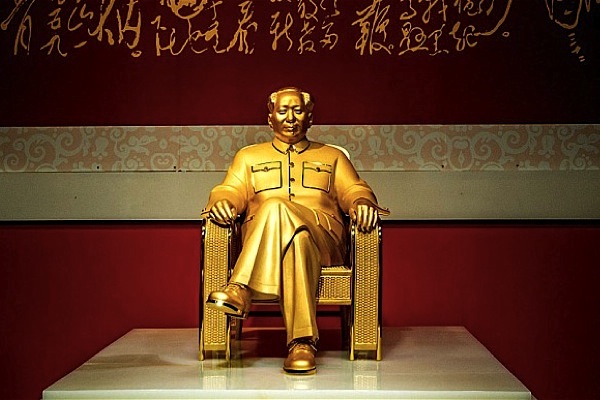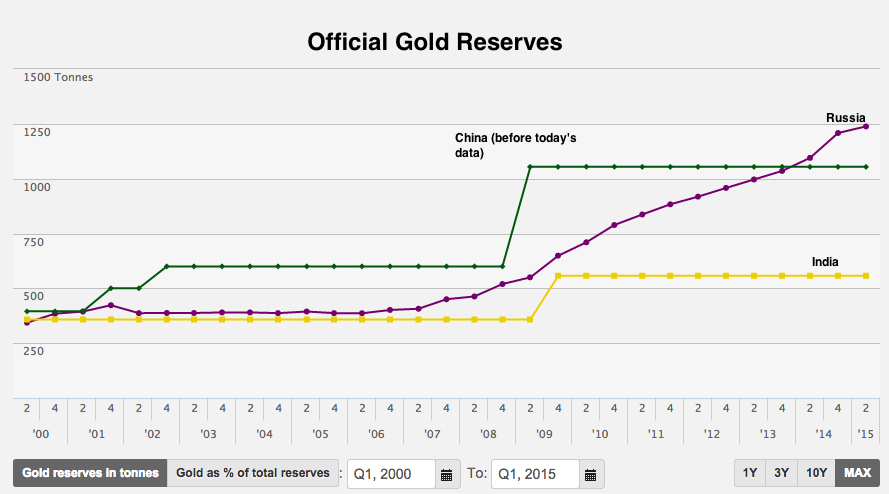
Eight solid gold statue of Mao Tse-tung, unveiled in Dec. 2013. (By Georg Denda | Wikimedia Commons)
China shocked the bullion market by unveiling Friday its official gold holdings for the first time since 2009, putting an end to years of speculation and rumours of Beijing quietly buying gold since prices began declining
According to data from the country’s central bank, China’s gold reserves stood at 1,658 tonnes (53.31m fine troy ounces) at the end of June. In April 2009, its gold holdings were 1,054 tonnes.
This 57% jump in reserves means that China now surpasses Russia in the list of countries with the largest stash of the yellow metal, placing it in the sixth position, after the US, Germany, the International Monetary Fund, Italy and France, according to the World Gold Council.

(Click to enlarge). Source: The World Gold Council, June 2015.
The surprising (and questionable) announcement comes at a time when the price of gold has dropped to near its lowest price since 2010.
It also follows several analyses that put China’s current holdings at least three times bigger than the figure last reported in April 2009. Bloomberg Intelligence actually estimated Beijing’s gold reserves above the 3,000 metric tons range last April, based on trade data, domestic output and China Gold Association figures.
The official numbers, while welcome, reveal that Beijing has been lying about how much gold has really bought and sell as of late. As Bussiness Insider puts it, “it is impossible the PBOC could have bought 600 tons of gold in the open market in June when the price of the yellow metal actually dropped by 2%.”
For Ross Norman, analyst at Sharps Pixley, there could be three main reasons why China has just now decided to publish official bullion reserves figures:
China is seeking a place at top table in financial markets by having its currency accepted under IMF rules (the so-called Special Drawing Rights) at a meeting to be held in October – in other words, to have the Yuan included by Central banks around the world as a reserve currency. As part of this process, China would need to fully declare its gold reserves; in that sense the timing is as expected – its just the amount that makes no sense.
Secondly, China is struggling with an equity market in free-fall and some have suggested that the timing of the declaration is to give comfort to domestic investors that their reserves are size-able … but that makes no sense either, because they aren’t !
The third explanation – and here we move into the under-world of conspiracies, is that China wants to downplay gold as part of its reserves – especially as they are world’s top buyers both for domestic jewellery and to top up their official reserves (yes they are also the top producers but they are significant net buyers). This is to say that China may be adopting the reverse of the UK policy of the late 1990’s where it telegraphed in advance to the world its intentions to sell most of its gold reserves – thereby prompting a fall in prices to a 21 year low … thank you Gordon Brown.
Gold extended this week loses Friday, hitting a fresh five-year low, since a stronger dollar and upbeat economic data bolstered investor expectations of higher interest rates in the U.S.
Bullion for August delivery was slipping by 1.08% to $1,131.50 per ounce on the COMEX this morning.
2 Comments
john S. metzger
“lying” noooo they’d never do that ….
Dylan E McFarlane
Chinese officials must be loving headlines like this. Of course they’ve lied about gold holdings, just like the USA has and others. It’s politics: “he who has the gold makes the rules” as the saying goes…Keep the price low, get more gold in the vault and to citizens, then join the global poker table (IMF) and exercise some power. I think I trust the physical gold holders in China more than the paper ETFs elsewhere, and it’s good news looking 5 or 10 years ahead in my opinion.